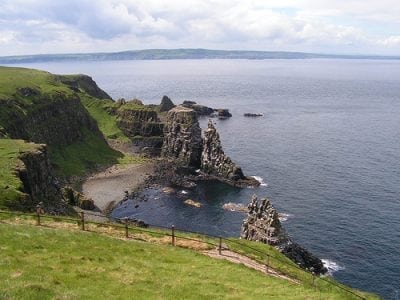- Created: August 28, 2012 10:32 am
- Updated: December 12, 2017 11:02 am
Categories:
Location: Antrim
- Distance Instructions
Label
- Distance 7 km
- Time 0 s
- Speed 0.0 km/h
- Min altitude 0 m
- Peak 91 m
- Climb 181 m
- Descent 194 m
At the western end of Rathlin Island, sheer cliffs rise more than 100 metres above raised beaches of rounded cobbles, while towering stacks of rock stand guard just off the shore. The best time of the year to visit Kebble is the height of the breeding season for seabirds, early May to mid July, when the rough faces of the cliffs and rocky islands are crowded with thousands of breeding seabirds. Guillemots, razorbills, kittiwakes and fulmars raise their young on bare ledges, while puffins nest in burrows dug into the cliff-side grassland. Peregrine falcons, buzzards and ravens also build nests on cliff ledges.
Early summer sees the island's orchids in bloom and a trip in August will be rewarded by the sight of the heathlands in full flower. Above the cliff top stretches an area of rough grassland and heather, broken by a lake and an area of marsh. These wet areas attract nesting waterfowl such as ducks, snipe, grebes and coots. Rabbits and hares graze on the reserve, while grey seals can be seen hauling themselves out onto the rocky foreshore.
Gallery
At the western end of Rathlin Island, sheer cliffs rise more than 100 metres above raised beaches of rounded cobbles, while towering stacks of rock stand guard just off the shore. The best time of the year to visit Kebble is the height of the breeding season for seabirds, early May to mid July, when the rough faces of the cliffs and rocky islands are crowded with thousands of breeding seabirds. Guillemots, razorbills, kittiwakes and fulmars raise their young on bare ledges, while puffins nest in burrows dug into the cliff-side grassland. Peregrine falcons, buzzards and ravens also build nests on cliff ledges.
Early summer sees the island’s orchids in bloom and a trip in August will be rewarded by the sight of the heathlands in full flower. Above the cliff top stretches an area of rough grassland and heather, broken by a lake and an area of marsh. These wet areas attract nesting waterfowl such as ducks, snipe, grebes and coots. Rabbits and hares graze on the reserve, while grey seals can be seen hauling themselves out onto the rocky foreshore.


